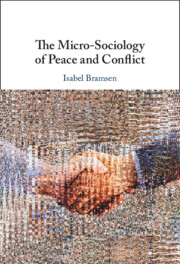Book contents
- The Micro-Sociology of Peace and Conflict
- The Micro-Sociology of Peace and Conflict
- Copyright page
- Contents
- Images
- Figures
- Tables
- Acknowledgments
- Abbreviations
- Introduction
- 1 The Theory of Micro-sociology
- 2 The Methods and Methodology of Micro-sociology
- 3 The Micro-sociology of Violence
- 4 The Micro-sociology of Nonviolent Resistance
- 5 The Micro-sociology of Conflict Transformation
- 6 The Micro-sociology of Peace Talks
- 7 The Micro-sociology of International Meetings
- Conclusion
- References
- Index
- References
References
Published online by Cambridge University Press: 26 October 2023
- The Micro-Sociology of Peace and Conflict
- The Micro-Sociology of Peace and Conflict
- Copyright page
- Contents
- Images
- Figures
- Tables
- Acknowledgments
- Abbreviations
- Introduction
- 1 The Theory of Micro-sociology
- 2 The Methods and Methodology of Micro-sociology
- 3 The Micro-sociology of Violence
- 4 The Micro-sociology of Nonviolent Resistance
- 5 The Micro-sociology of Conflict Transformation
- 6 The Micro-sociology of Peace Talks
- 7 The Micro-sociology of International Meetings
- Conclusion
- References
- Index
- References
Summary
- Type
- Chapter
- Information
- The Micro-Sociology of Peace and Conflict , pp. 225 - 251Publisher: Cambridge University PressPrint publication year: 2023
- Creative Commons
- This content is Open Access and distributed under the terms of the Creative Commons Attribution licence CC-BY-NC 4.0 https://creativecommons.org/cclicenses/



